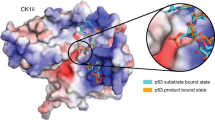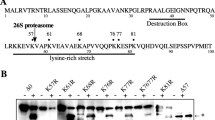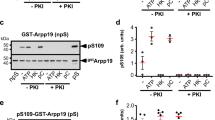Abstract
IN vertebrates, unfertilized eggs are arrested at second meiotic metaphase by a cytostatic factor (CSF)1, an essential component of which is the product of the c-mos proto-oncogene2. CSF prevents ubiquitin-dependent degradation of mitotic cyclins and thus inactivation of the M phase-promoting factor (MPF)3,4.Fertilization or parthenogenetic activation triggers a transient increase in the cytoplasmic free Ca2+ (reviewed in refs 5 and 6), inactivates both CSF and MPF, and releases eggs from meiotic metaphase arrest7–10. A calmodulin-dependent process is required for cyclin degradation to occur in cell-free extracts prepared from metaphase II-arrested eggs (CSF extracts) when the free Ca2+concentration is transiently raised in the physiological micromolar range10. Here we show that when a constitutively active mutant of calmodulin-dependent protein kinase II (CaM KII) is added to a CSF extract, cyclin degradation and Cdc2 kinase inactivation occur even in the absence of Ca2+, and the extract loses its ability to cause metaphase arrest when transferred into embryos. Furthermore, specific inhibitors of CaM KIIprevent cyclin degradation after calcium addition. Finally, the direct microinjection of constitutively active CaM KH into unfertilized eggs inactivates Cdc2 kinase and CSF, even in the absence of a Ca2+ transient. The target for Ca2+calmodulin is thus CaM KII.
This is a preview of subscription content, access via your institution
Access options
Subscribe to this journal
Receive 51 print issues and online access
$199.00 per year
only $3.90 per issue
Buy this article
- Purchase on Springer Link
- Instant access to full article PDF
Prices may be subject to local taxes which are calculated during checkout
Similar content being viewed by others
References
Masui, Y. & Markert, C. L. J. exp. Zool. 177, 129–146 (1971).
Sagata, N., Watanabe, N., Vande Woude, G. F. & Ikawa, Y. Nature 342, 512–518 (1989).
Glotzer, M., Murray, A. W. & Kirschner, M. W. Nature 349, 132–138 (1991).
Murray, A. W., Solomon, M. J. & Kirschner, M. W. Nature 339, 280–286 (1989).
Jaffe, L. Devl Biol. 99, 265–276 (1983).
Berridge, M. J. Nature 361, 315–325 (1993).
Meyerhof, P. G. & Masui, Y. Devl Biol. 61, 214–229 (1977).
Watanabe, N., Hunt, T., Ikawa, Y. & Sagata, N. Nature 352, 247–248 (1991).
Weber, M., Kubiak, J. Z., Arlinghaus, R. B., Pines, J. & Maro, B. Devl Biol. 148, 393–397 (1991).
Lorca, T. et al. EMBO J. 10, 2087–2093 (1991).
Blumenthal, D. K. et al. Proc. natn. Acad. Sci. U.S.A. 82, 3187–3191 (1985).
Olson, N. J. et al. Proc. natn. Acad. Sci. U.S.A. 87, 2284–2288 (1990).
Cheung, W. Y. J. biol. Chem. 246, 2859–2869 (1971).
Depaoli-Roach, A. A., Gibbs, J. B. & Roach, P. FEBS Lett. 105, 321–324 (1979).
Niggli, U., Adunyah, E. S. & Carafoli, E. J. biol. Chem. 256, 8588–8592 (1981).
Manalan, A. S. & Klee, C. B. Proc. natn. Acad. Sci. U.S.A. 80, 4291–4295 (1983).
Cruzalegui, F. H. et al. Proc. natn. Acad. Sci. U.S.A. 89, 12127–12131 (1992).
Pausch, M. H., Kaim, D., Kunisawa, R., Admon, A. & Thorner, J. EMBO J. 10, 1511–1522 (1991).
Söderling, T. R. J. biol. Chem. 265, 1823–1826 (1990).
Payne, M. E. et al. J. biol. Chem. 263, 7190–7195 (1988).
Malinow, R., Schulman, H. & Tsien, R. W. Science 245, 862–866 (1989).
Schulman, H. & Lou, L. L. Trends biochem. Sci. 14, 62–66 (1989).
Colbran, R. J., Fong, Y. L., Schworer, C. M. & Söderling, T. R. J. biol. Chem. 263, 18145–18151 (1988).
Pearson, R. B. & Kemp, B. E. Meth. Enzym. 200, 62–81 (1991).
Woodgett, J. R., Davison, M. T. & Cohen, P. Eur. J. Biochem. 136, 481–488 (1983).
Smith, M. K., Colbran, R. J. & Söderling, T. R. J. biol. Chem. 265, 1837–1840 (1990).
Lorca, T. et al. J. Cell Sci. 102, 55–62 (1992).
Labbé, J. C., Cavadore, J. C. & Dorée, M. Meth. Enzym. 200, 291–301 (1991).
Wangh, L. J. Cell Sci. 93, 1–8 (1989).
Author information
Authors and Affiliations
Rights and permissions
About this article
Cite this article
Lorca, T., Cruzalegui, F., Fesquet, D. et al. Calmodulin-dependent protein kinase II mediates inactivation of MPF and CSF upon fertilization of Xenopus eggs. Nature 366, 270–273 (1993). https://doi.org/10.1038/366270a0
Received:
Accepted:
Issue Date:
DOI: https://doi.org/10.1038/366270a0
This article is cited by
-
Stop and go: Oocyten auf ihrem Weg zu einer befruchtungsfähigen Eizelle
BIOspektrum (2020)
-
AMPK-mediated activation of MCU stimulates mitochondrial Ca2+ entry to promote mitotic progression
Nature Cell Biology (2019)
-
Post-translational regulation of the maternal-to-zygotic transition
Cellular and Molecular Life Sciences (2018)
-
Ca2+ dynamics in oocytes from naturally-aged mice
Scientific Reports (2016)
-
Structural basis for recognition of Emi2 by Polo-like kinase 1 and development of peptidomimetics blocking oocyte maturation and fertilization
Scientific Reports (2015)
Comments
By submitting a comment you agree to abide by our Terms and Community Guidelines. If you find something abusive or that does not comply with our terms or guidelines please flag it as inappropriate.



